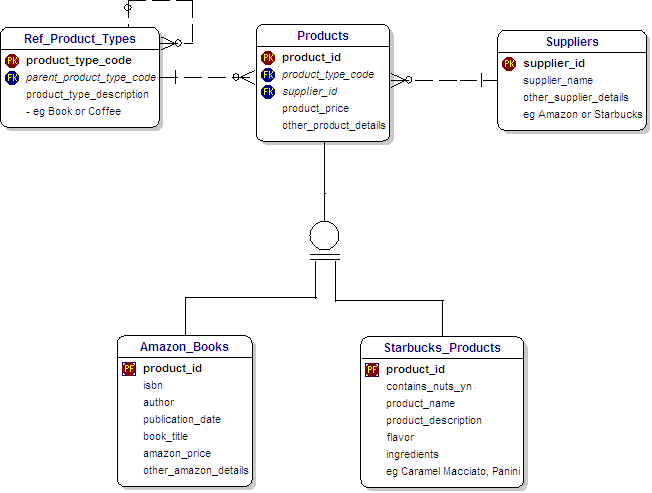Tutorial on Database Schema - Slide 8 - Products at Amazon.com or Starbucks
Back Next Slide
- Products at Amazon.com or Starbucks
- Product Types (Inheritance and Recursion).

Products
Let's move on to the topic of Products. As you might imagine, this can be a complex area.
Two important aspects are Inheritance and Product Hierarchies.
Inheritance
This diagram shows a 'Products' table that holds details that are common to all Products.
It shows an 'Amazon_Books' table that holds details that are specific to Books from Amazon.
It also shows a 'Starbucks_Products' table that holds details that are specific to Products from Starbucks.
These two are Children of the Parent 'Products' Table.
Therefore, this concept is referred to as Inheritance and is very powerful in the real world.
On the diagram, it is shown by the circle with two short horizontal lines underneath it.
Data Modellers define these as 'Sub-Types' of a 'Super-Type'.
This diagram shows the Logical level of the Schema.
At the physical level, this can be implemented in one of three ways :-
- Three tables - exactly like the Logical level.
- Two tables - one for Amazon and one for Starbucks, with the common data items copied down from the Parent Table.
- One table - at the higher level, with common data items and those for Amazon and Starbucks all in one large table.
Recursive Product Hierarchy
The line that comes out of the Ref_Product_Types Table and then goes back in again is informally called a 'Rabbits Ear',
or more formally a 'Recursive Relationship'. It defines a Product Hierarchy.
It means that any Product can be part of a higher grouping of Products, such as Categories, Types and so on.
This is a very neat and powerful way to implement this concept.
In our example, the 'parent_product_type_code' is a reference to the next highest level in the hierarchy.
Suppliers
I introduce Suppliers at this point because Starbucks and Amazon.com are both Suppliers of Products within our Schema.
This would be the starting-point for Schema involving a more detailed analysis of Suppliers.
© DataBaseAnswers.org 2006
